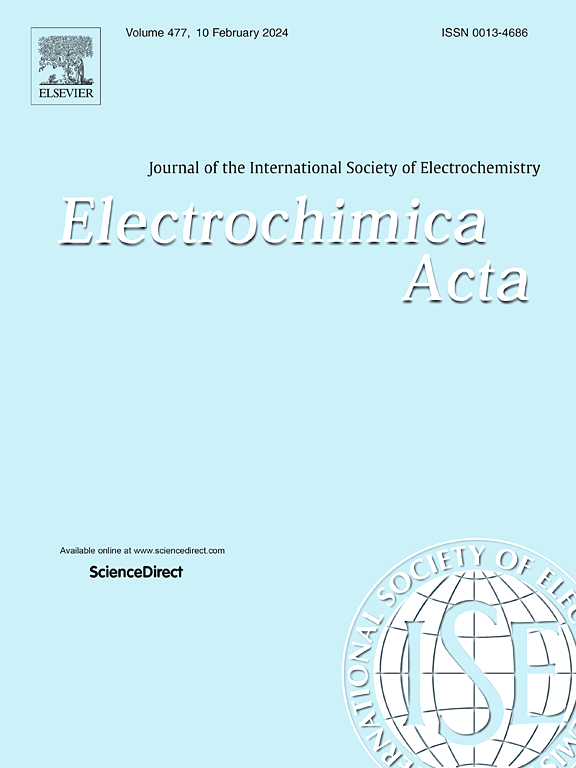Degradation of acridine orange using sustainable bio-electro-Fenton and bio-electro-peroxone systems with MIL-53(Fe)-derived Fe3O4 and MWCNT composite: A comparative assessment
IF 5.5
3区 材料科学
Q1 ELECTROCHEMISTRY
引用次数: 0
Abstract
The present investigation articulates the application of a MIL-53(Fe) metal-organic framework (MOF)-derived Fe3O4 and multi-walled carbon nanotubes (cFe@MWCNT) composite as cathode catalyst in bio-electro-Fenton (BEF) and bio-electro-peroxone (BEP) systems. Both the systems were comparatively inspected for the in-situ production of hydrogen peroxide (H2O2), further turning into hydroxyl radical (˙OH) to degrade the acridine orange (ACO) dye. The k value for the degradation of ACO in BEF-cFe@MWCNT was 0.0075 min−1, which was 17.3-fold lower than the k value attained by the BEP-cFe@MWCNT system (0.1298 min−1). Interestingly, the baffling in the BEP system increased the degradation rate from 0.0575 to 0.1298 min−1. Further, the ACO degradation in the secondary treated sewage was determined to be 78.51 ± 3.02% (240 min) and 83.2 ± 2.7% (50 min) in BEF-cFe@MWCNT and BEP-cFe@MWCNT, respectively. The demethylation reaction, initiated by the ˙OH attack, was identified as the primary pathway for ACO degradation in both systems. Simultaneously, the intrinsic microbial activity in the anodic chamber was capable of generating power of 120.0 ± 2.2 and 103.6 ± 4.7 mW m−2 in BEF and BEP, respectively. A comprehensive comparative assessment of both systems was conducted based on pollutant degradation, power generation, and operational cost. Overall, results indicated the superiority of the baffled BEP-cFe@MWCNT system towards emerging contaminant degradation in a shorter reaction time and affirmed its practical feasibility in wastewater treatment.

MIL-53(Fe)衍生Fe3O4和MWCNT复合材料可持续生物电- fenton和生物电-过氧化物酮体系降解吖啶橙的比较评价
本研究阐明了MIL-53(Fe)金属有机骨架(MOF)衍生的Fe3O4和多壁碳纳米管(cFe@MWCNT)复合材料作为阴极催化剂在生物电- fenton (BEF)和生物电-过氧酮(BEP)体系中的应用。比较了两种体系的原位生成过氧化氢(H2O2),并进一步转化为羟基自由基(˙OH)来降解吖啶橙(ACO)染料。BEF-cFe@MWCNT体系降解ACO的k值为0.0075 min−1,比BEP-cFe@MWCNT体系的k值(0.1298 min−1)低17.3倍。有趣的是,BEP系统中的挡板将降解率从0.0575提高到0.1298 min−1。此外,在BEF-cFe@MWCNT和BEP-cFe@MWCNT中,二级处理污水的ACO降解率分别为78.51±3.02% (240 min)和83.2±2.7% (50 min)。在这两个系统中,由˙OH攻击引发的去甲基化反应被确定为ACO降解的主要途径。同时,阳极室的微生物活性在BEF和BEP中分别能够产生120.0±2.2和103.6±4.7 mW m−2的功率。根据污染物降解、发电量和运行成本对两种系统进行了综合比较评估。总体而言,研究结果表明了折流板BEP-cFe@MWCNT系统在较短反应时间内降解新兴污染物的优势,并肯定了其在废水处理中的实际可行性。
本文章由计算机程序翻译,如有差异,请以英文原文为准。
求助全文
约1分钟内获得全文
求助全文
来源期刊

Electrochimica Acta
工程技术-电化学
CiteScore
11.30
自引率
6.10%
发文量
1634
审稿时长
41 days
期刊介绍:
Electrochimica Acta is an international journal. It is intended for the publication of both original work and reviews in the field of electrochemistry. Electrochemistry should be interpreted to mean any of the research fields covered by the Divisions of the International Society of Electrochemistry listed below, as well as emerging scientific domains covered by ISE New Topics Committee.
 求助内容:
求助内容: 应助结果提醒方式:
应助结果提醒方式:


